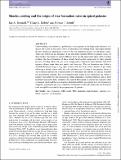Files in this item
Shocks, cooling and the origin of star formation rates in spiral galaxies
Item metadata
| dc.contributor.author | Bonnell, Ian Alexander | |
| dc.contributor.author | Dobbs, Clare L. | |
| dc.contributor.author | Smith, Rowan J. | |
| dc.date.accessioned | 2014-08-13T09:31:01Z | |
| dc.date.available | 2014-08-13T09:31:01Z | |
| dc.date.issued | 2013-04-11 | |
| dc.identifier | 24987512 | |
| dc.identifier | 33e5023d-34aa-407d-a299-4a4d09202f4d | |
| dc.identifier | 84876791122 | |
| dc.identifier.citation | Bonnell , I A , Dobbs , C L & Smith , R J 2013 , ' Shocks, cooling and the origin of star formation rates in spiral galaxies ' , Monthly Notices of the Royal Astronomical Society , vol. 430 , no. 3 , pp. 1790-1800 . https://doi.org/10.1093/mnras/stt004 | en |
| dc.identifier.issn | 0035-8711 | |
| dc.identifier.uri | https://hdl.handle.net/10023/5131 | |
| dc.description | IAB acknowledges funding from the European Research Council for the FP7 ERC advanced grant project ECOGAL. CLD acknowledges funding from the European Research Council for the FP7 ERC starting grant project LOCALSTAR. RJS acknowledges support for grant SM321/1-1 from the DFG Priority Program 1573, ‘The Physics of the Interstellar Medium’. | en |
| dc.description.abstract | Understanding star formation is problematic as it originates in the large-scale dynamics of a galaxy but occurs on the small scale of an individual star-forming event. This paper presents the first numerical simulations to resolve the star formation process on sub-parsec scales, whilst also following the dynamics of the interstellar medium (ISM) on galactic scales. In these models, the warm low-density ISM gas flows into the spiral arms where orbit crowding produces the shock formation of dense clouds, held together temporarily by their external pressure. Cooling allows the gas to be compressed to sufficiently high densities that local regions collapse under their own gravity and form stars. The star formation rates follow a Schmidt–Kennicutt ΣSFR∝Σ1.4gas type relation with the local surface density of gas while following a linear relation with the cold and dense gas. Cooling is the primary driver of star formation and the star formation rates as it determines the amount of cold gas available for gravitational collapse. The star formation rates found in the simulations are offset to higher values relative to the extragalactic values, implying a constant reduction, such as from feedback or magnetic fields, is likely to be required. Intriguingly, it appears that a spiral or other convergent shock and the accompanying thermal instability can explain how star formation is triggered, generate the physical conditions of molecular clouds and explain why star formation rates are tightly correlated to the gas properties of galaxies. | |
| dc.format.extent | 11 | |
| dc.format.extent | 5273567 | |
| dc.language.iso | eng | |
| dc.relation.ispartof | Monthly Notices of the Royal Astronomical Society | en |
| dc.subject | Stars: formation | en |
| dc.subject | Galaxies: star formation | en |
| dc.subject | Galaxies: evolution | en |
| dc.subject | ISM: kinematics and dynamics | en |
| dc.subject | ISM: clouds | en |
| dc.subject | QB Astronomy | en |
| dc.subject.lcc | QB | en |
| dc.title | Shocks, cooling and the origin of star formation rates in spiral galaxies | en |
| dc.type | Journal article | en |
| dc.contributor.sponsor | Science & Technology Facilities Council | en |
| dc.contributor.sponsor | European Research Council | en |
| dc.contributor.institution | University of St Andrews. School of Physics and Astronomy | en |
| dc.identifier.doi | 10.1093/mnras/stt004 | |
| dc.description.status | Peer reviewed | en |
| dc.identifier.grantnumber | ST/J001651/1 | en |
| dc.identifier.grantnumber | en |
This item appears in the following Collection(s)
Items in the St Andrews Research Repository are protected by copyright, with all rights reserved, unless otherwise indicated.

